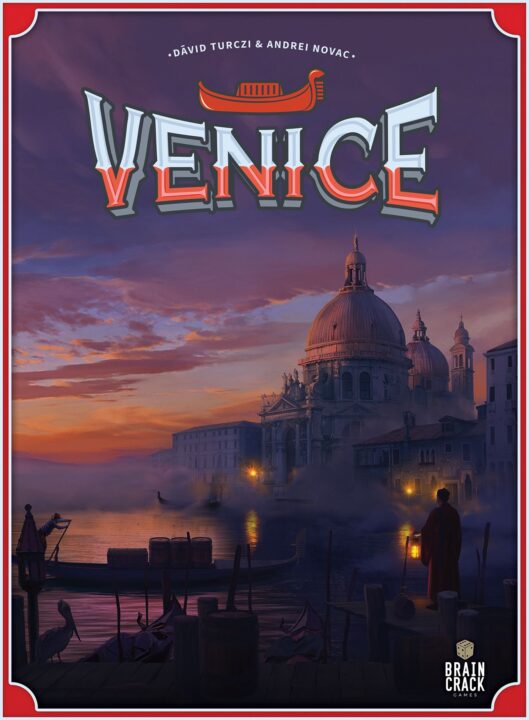It’s time for another board game review, and friends, you might want to grab your fanciest hat (trust me, it helps set the mood). This time, I took a trip down the soggy alleyways of Venice—yes, the city with all the canals and the very expensive coffee. I played with a crew of my usual suspects, and no one got thrown into the water (yet). Here, I’ll share my honest take on everything from shady gondola rides to how pretty the board looks on your table. Was it a smooth cruise or did we capsize? Let’s find out.
How It Plays
Setting up
First, toss that big board on the table so Venice’s canals run wild. Give every player a gondola, some assistants, and your very own noble pawn. Deal out starting resources. Place workshops on the board, shuffle the intrigue deck, and set the score track to zero. Get ready to cause some trouble!
Gameplay
On your turn, you move your gondola around the canals, dropping off assistants at different buildings. Those assistants help you collect goods, money, and the all-important favor of Venice’s nobility. Watch out—if you get too greedy and bump into other boats, you might end up with intrigue tokens, which are bad news. People in Venice talk, trust me. You can also train your assistants, bribe officials, and upgrade your gondola. It’s kind of like Uber for spies, but with more wigs and fewer GPS errors.
Winning the game
The game ends when someone finishes their last delivery, or when the intrigue track gets too hot and triggers an investigation. Count up prestige points from your deliveries, secret missions, and upgrades. Subtract points if the investigation sent you into exile (bye-bye, Venice). The player with the most points wins and gets to brag about their slick Venetian moves at the next pizza night.
Want to know more? Read our extensive strategy guide for Venice.
How Venice Plays: Boats, Bribes, and Backstabbing
Alright folks, let’s talk about the guts of Venice. If you ever wanted to know how it feels to be a sneaky merchant zooming around canals on a gondola, Venice is the game for you. Every turn, I got to move my little boat around the map, stopping at different buildings to do stuff like trade goods or scheme with the locals. At one point, I bribed my own friend just to get a tiny edge. She did not forgive me.
One thing I have to say about Venice: it hates boring players. You can’t just sit and quietly collect resources. Oh, no. The game throws in a bit of engine-building, where you upgrade your fancy little assistants at buildings to pull off crazy combos. Sometimes I felt like an evil genius, other times like a merchant with two left feet. One bad turn and boom, you’re stuck paying the authorities (or worse, getting kicked out of the city).
Venice shines in player interaction. I found out the hard way that you need to be on your toes, because if you let someone get too sneaky with their ‘corruption’ points, they can drag you down too. Players can mess with each other by blocking paths, taking actions first, or even framing rivals (I’m not saying I did this, but my friends know the truth). The best part? The game balances competition and cooperation, so while you might plot against each other, you sometimes need to team up to avoid disaster. It’s messy, it’s loud, and it’s a blast—unless you hate a little chaos in your game night.
Next up, let’s see if the art and theme of Venice is as beautiful as those canals—or just a puddle with cardboard boats.
Theme and Artwork: Sailing through the Sights of Venice
Let me just say this: if you’ve ever wanted to dress up as a masked noble and float around Venice in a gondola, but you’re afraid of leaving your couch, this game nails the vibe. Venice drips with theme. Every card, tile, and little wooden gondola yells, “Ciao, I’m here to party on the canal!” My friends said the game should come with a complimentary espresso and a tiny pigeon.
The board is basically a frenzied tourist map of Venice. It’s busy—almost too busy—but that fits right in. The artwork bursts with color. Every building has personality, from crumbling stone bridges to the kind of fancy windows I’d probably break if I ever visited in person. There are little details everywhere. Even the player aids look like they belong in a secret Venetian society for people with bad handwriting. I spent a solid minute just admiring the gondolas before someone reminded me it was my turn, which then led to more admiring while pretending to plan my move.
The theme and artwork work hand in hand. Sure, there’s a bit of information overload at first. But, after a round or two, you start feeling like a sneaky merchant, eyeing the canals for your next move, and side-eyeing your friends’ gondolas. The aesthetic isn’t just for show—it really pulls you into the city. But hang tight, because next I’ll be telling you if the luck of the draw will sink your gondola, or if strategy gets you a free ride through those watery streets!
Strategy vs. Luck: Who Really Runs Venice?
Alright, let’s talk turkey. Or, in this case, gondolas and sneaky councilmen. One thing I always check before buying a game is whether I’ll win because I had a master plan, or because I just got lucky drawing cards. In Venice, it’s definitely more about clever planning than just rolling dice and crossing your fingers.
You get plenty of chances to outsmart your friends. Everyone starts with the same set of options, which is great. The heart of the game is building your engine so you can do things more efficiently. I made a point of planning out my routes and moves like a weird, board game version of a travel agent. And when my plan worked and my gondola slipped ahead, it felt amazing. My friend Greg, on the other hand, tried winging it. He spent half the game taking detours and ended up with more intrigue cubes than points. So yes, planning pays off.
But – and it’s a chunky but – there’s still a lucky side. The order of cards, the timing of events, even who moves their gondola where… sometimes you just get a weird setup and your plan falls to pieces. That can be funny, but it can also be annoying if it happens too often. Sometimes a player can swoop in with a lucky move that nobody saw coming, and steal victory from under your nose. It’s not unfair, but luck does play a part, so don’t expect pure chess-level strategy.
So, Venice balances smarts and luck, but it leans more towards rewarding brains – unless the fates decide otherwise.
Now, let’s spin those gondolas into the next canal—will you want to play Venice over and over, or is it one splash and done? Find out in the next section on replay value and game length!
How Often Can You Set Sail? Venice’s Replay Value and Game Length
Let me tell you, replay value is huge for me. I get grumpy if a game turns into shelf décor after one play. So, how does Venice do on this front? I was honestly surprised. Every game I played with my crew felt different. There are a ton of strategies to try out and new ways to mess with your friends. I mean, I’ve had so many grudges form at my table just because of some classic gondolier sabotage. If you love that, Venice is a goldmine.
The replayability comes from the variety of actions and random setup. You have different mentor cards, secret missions, and shifting opportunities every game. Even after a bunch of rounds, we kept finding new combos and ways to win. Plus, the social aspect means it never feels stale—unless your group has trust issues. (Which, after Venice, they might!)
Game length? It lands in the sweet spot for me: usually about 90 minutes. My most distracted group (bless them) managed to drag it out to two hours, but I wouldn’t blame the game for that. Venice doesn’t overstay its welcome. It ramps up in tension right until the finish, like a good espresso shot.
Do I recommend Venice? If you want a game that keeps you coming back and rarely feels the same, this is an easy yes. Unless you hate navigating tiny wooden gondolas. In that case, maybe get a puzzle instead.
Conclusion
Well, that wraps up my gondola-filled journey through Venice. This game left me feeling like a sneaky merchant—sometimes clever, sometimes caught red-handed by my friends. The artwork is fantastic and I could almost smell the canal (don’t worry, in a good way). I loved the constant player interaction and the different ways you can win.
But, be warned: some luck can sneak up and bite you like a hungry Venetian pigeon. If you don’t mind a bit of randomness and enjoy strategy, Venice is a solid pick for game night. Just don’t spill any wine on those pretty canals.
Thanks for reading my review! Now, excuse me while I practice my gondolier singing voice for the next round.


